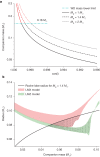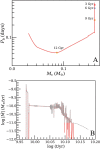A binary pulsar in a 53-minute orbit
- PMID: 37339734
- PMCID: PMC10468392
- DOI: 10.1038/s41586-023-06308-w
A binary pulsar in a 53-minute orbit
Abstract
Spider pulsars are neutron stars that have a companion star in a close orbit. The companion star sheds material to the neutron star, spinning it up to millisecond rotation periods, while the orbit shortens to hours. The companion is eventually ablated and destroyed by the pulsar wind and radiation1,2. Spider pulsars are key for studying the evolutionary link between accreting X-ray pulsars and isolated millisecond pulsars, pulsar irradiation effects and the birth of massive neutron stars3-6. Black widow pulsars in extremely compact orbits (as short as 62 minutes7) have companions with masses much smaller than 0.1 M⊙. They may have evolved from redback pulsars with companion masses of about 0.1-0.4 M⊙ and orbital periods of less than 1 day8. If this is true, then there should be a population of millisecond pulsars with moderate-mass companions and very short orbital periods9, but, hitherto, no such system was known. Here we report radio observations of the binary millisecond pulsar PSR J1953+1844 (M71E) that show it to have an orbital period of 53.3 minutes and a companion with a mass of around 0.07 M⊙. It is a faint X-ray source and located 2.5 arcminutes from the centre of the globular cluster M71.
© 2023. The Author(s).
Conflict of interest statement
The authors declare no competing interests.
Figures






Similar articles
-
A highly magnetized environment in a pulsar binary system.Nature. 2023 Jun;618(7965):484-488. doi: 10.1038/s41586-023-05983-z. Epub 2023 May 17. Nature. 2023. PMID: 37198492
-
Binary and Millisecond Pulsars.Living Rev Relativ. 2008;11(1):8. doi: 10.12942/lrr-2008-8. Epub 2008 Nov 4. Living Rev Relativ. 2008. PMID: 28179824 Free PMC article. Review.
-
A 62-minute orbital period black widow binary in a wide hierarchical triple.Nature. 2022 May;605(7908):41-45. doi: 10.1038/s41586-022-04551-1. Epub 2022 May 4. Nature. 2022. PMID: 35508781
-
An eccentric binary millisecond pulsar in the galactic plane.Science. 2008 Jun 6;320(5881):1309-12. doi: 10.1126/science.1157580. Epub 2008 May 15. Science. 2008. PMID: 18483399
-
Binary and Millisecond Pulsars.Living Rev Relativ. 2005;8(1):7. doi: 10.12942/lrr-2005-7. Epub 2005 Nov 9. Living Rev Relativ. 2005. PMID: 28179869 Free PMC article. Review.
Cited by
-
TCAD Simulation Study of Electrical Performance of a Novel High-Purity Germanium Drift Detector.Micromachines (Basel). 2025 Feb 17;16(2):229. doi: 10.3390/mi16020229. Micromachines (Basel). 2025. PMID: 40047664 Free PMC article.
References
-
- Van den Heuvel, E. P. J. & Van Paradijs, J. Fate of the companion stars of ultra-rapid pulsars. Nature334, 227–228 (1988).
-
- Roberts, M. S. E. in Neutron Stars and Pulsars: Challenges and Opportunities after 80 Years Vol. 291 (ed. van Leeuwen, J.) 127–132 (Cambridge Univ. Press, 2013).
-
- Kluzniak W, Ruderman M, Shaham J, Tavani M. Nature and evolution of the eclipsing millisecond binary pulsar psr1957 + 20. Nature. 1988;334:225–227. doi: 10.1038/334225a0. - DOI
-
- Ruderman M, Shaham J, Tavani M. Accretion turnoff and rapid evaporation of very light secondaries in low-mass X-ray binaries. Astrophys. J. 1989;336:507. doi: 10.1086/167029. - DOI
-
- Strader J, et al. Optical spectroscopy and demographics of redback millisecond pulsar binaries. Astrophys. J. 2019;872:42. doi: 10.3847/1538-4357/aafbaa. - DOI
LinkOut - more resources
Full Text Sources

